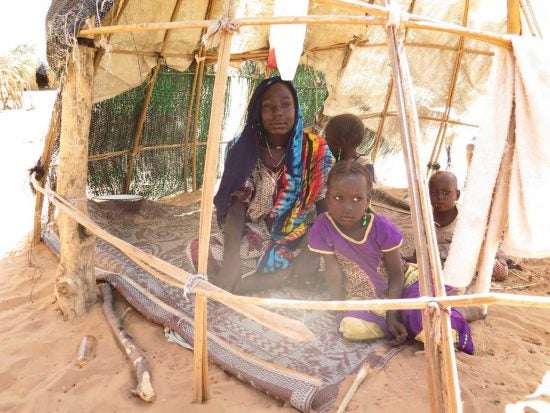
A family internally displaced in Chad, among a record nearly 51 million internally displaced people in 2019. Image courtesy of UN OHCA.
Wealthy governments are mobilizing unprecedented levels of resources for domestic COVID-19 response and economic stimulus packages. To the tragically small extent they are also offering support to lower-income countries, they are either reprogramming assistance – as with the European Union’s 15.6 billion euro package – or allocating trifling amounts compared to the need. The United States, for example, has included $2.4 billion for international assistance in the emergency COVID-19 spending measures of the past several months. The needs of lower–income countries are hundreds of billions of dollars, if not support that totals well over a trillion dollars.
Existing international assistance resources reallocated to COVID-19. Countries not willing to spend anywhere near the needed levels to support lower-income countries during this monumental global crisis. The world focused on COVID-19. All this creates a grave risk to the lives of some of the most marginalized, vulnerable people in the world before COVID-19 struck – who are even more vulnerable today. These are the well over 100 million people who depend on the international community to meet their basic needs. Many are refugees, internally displaced persons, or asylum seekers. All have had calamity fall upon them, whether the result of conflict or a natural (or increasingly these days, mixed natural and manmade) disaster .
As of the beginning of April, more than 180 million people in 57 countries needed humanitarian support; UN agencies and its partners were reaching 117 million. Contributions to UN humanitarian appeals to support food, medical care, sanitation, education, and other necessities was lagging. As May began, though the year was about 33% through, the appeals, totaling just under $30 billion plus the $2.01 billion COVID-19 appeal, were only 13% funded. (Other information suggests the appeals are 24% funded, based on one set of figures of contributions thus far.)
This comes even as refugees and other people relying on international aid are at heightened risk of COVID-19 due to often crowded living conditions and limited access to health care and basic hygiene. Protecting them from COVID-19 is the focus of the COVID-19 UN appeal.
The United States is traditionally the largest funder of these appeals – though presently, only barely, with $1.4–$1.5 billion contributed, about 20% of the total contributions.
More will surely follow. How much? Let us take 2019 as a guide. Last year, the United States was the largest contributor to UN humanitarian appeals, providing $6.7 billion, or 38% of the total contributions – a reasonable amount of the total contributions, but for the fact that total contributions fell $11 billion short. Only 63% of the funding need across UN appeals was met, similar to other recent years.
Let us assume that the United States picks up the pace of contributions, and again provides 38% of the total contributions. Let us further assume that again only 63% of the 2020 appeal is funded. That would leave the $31.7 billion appeal short close to $12 billion. At 38% of the total, the United States share of this middle-of-the-road estimate of the likely gap would be about $4.5 billion of the UN humanitarian appeal, the vast majority of which (about $4.2 billion) would be for the nearly $30 billion in appeals not directly related to COVID-19, even as all of these humanitarian emergencies must deal with the COVID-19 emergency atop the existing crises.
Accordingly, given the risk facing the well over 100 million people whom humanitarian assistance is reaching, and the tens of millions of people of people even now now receiving aid, to having their needs neglected as the world turns to COVID-19, if the United States were act like a global leader, here’s the least we would do. We would commit to continuing to provide billions more of humanitarian assistance over the course of the year, at a minimum in line with the proportion of the appeal and total contributions as last year – though better still, we would speed up these contributions. And we would immediately appropriate, on top of what is in the pipeline, an additional $4 billion or more to support UN humanitarian appeals around the world – along, of course, with vastly increasing our global COVID-19 response funding.



